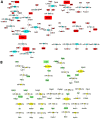Integrative microRNA and mRNA expression profiling in acute aristolochic acid nephropathy in mice
- PMID: 32945497
- PMCID: PMC7453650
- DOI: 10.3892/mmr.2020.11444
Integrative microRNA and mRNA expression profiling in acute aristolochic acid nephropathy in mice
Abstract
In acute aristolochic acid nephropathy (AAN), aristolochic acid (AA) induces renal injury and tubulointerstitial fibrosis. However, the roles of microRNAs (miRNAs/miRs) and mRNAs involved in AAN are not clearly understood. The aim of the present study was to examine AA‑induced genome‑wide differentially expressed (DE) miRNAs and DE mRNAs using deep sequencing in mouse kidneys, and to analyze their regulatory networks. In the present self‑controlled study, mice were treated with 5 mg/kg/day AA for 5 days, following unilateral nephrectomy. AA‑induced renal injury and tubulointerstitial fibrosis were detected using hematoxylin and eosin staining and Masson's trichrome staining in the mouse kidneys. A total of 82 DE miRNAs and 4,605 DE mRNAs were identified between the AA‑treated group and the self‑control group. Of these DE miRNAs and mRNAs, some were validated using reverse transcription‑quantitative PCR. Expression levels of the profibrotic miR‑21, miR‑433 and miR‑132 families were significantly increased, whereas expression levels of the anti‑fibrotic miR‑122‑5p and let‑7a‑1‑3p were significantly decreased. Functions and signaling pathways associated with the DE miRNAs and mRNAs were analyzed using Gene Ontology and Kyoto Encyclopedia of Genes and Genomes (KEGG). A total of 767 DE pairs (in opposing directions) of miRNAs and their mRNA targets were identified. Among these, regulatory networks of miRNAs and mRNAs were analyzed using KEGG to identify enriched signaling pathways and extracellular matrix‑associated pathways. In conclusion, the present study identified genome‑wide DE miRNAs and mRNAs in the kidneys of AA‑treated mice, as well as their regulatory pairs and signaling networks. The present results may improve the understanding of the role of DE miRNAs and their mRNA targets in the pathophysiology of acute AAN.
Figures







Similar articles
-
Integrated microRNA, mRNA, and protein expression profiling reveals microRNA regulatory networks in rat kidney treated with a carcinogenic dose of aristolochic acid.BMC Genomics. 2015 May 8;16(1):365. doi: 10.1186/s12864-015-1516-2. BMC Genomics. 2015. PMID: 25952319 Free PMC article.
-
Identification of Serum Exosome-Derived circRNA-miRNA-TF-mRNA Regulatory Network in Postmenopausal Osteoporosis Using Bioinformatics Analysis and Validation in Peripheral Blood-Derived Mononuclear Cells.Front Endocrinol (Lausanne). 2022 Jun 9;13:899503. doi: 10.3389/fendo.2022.899503. eCollection 2022. Front Endocrinol (Lausanne). 2022. PMID: 35757392 Free PMC article.
-
MicroRNA transcriptome profiling of mice brains infected with Japanese encephalitis virus by RNA sequencing.Infect Genet Evol. 2016 Apr;39:249-257. doi: 10.1016/j.meegid.2016.01.028. Epub 2016 Feb 2. Infect Genet Evol. 2016. PMID: 26845346
-
Whole transcriptome analysis of the differential RNA profiles and associated competing endogenous RNA networks in LPS-induced acute lung injury (ALI).PLoS One. 2021 May 7;16(5):e0251359. doi: 10.1371/journal.pone.0251359. eCollection 2021. PLoS One. 2021. PMID: 33961683 Free PMC article.
-
Targeting non-coding RNA for the therapy of renal disease.Curr Opin Pharmacol. 2016 Apr;27:70-7. doi: 10.1016/j.coph.2016.02.001. Epub 2016 Feb 26. Curr Opin Pharmacol. 2016. PMID: 26921871 Review.
Cited by
-
Radix Rehmannia Glutinosa inhibits the development of renal fibrosis by regulating miR-122-5p/PKM axis.Am J Transl Res. 2022 Jan 15;14(1):103-119. eCollection 2022. Am J Transl Res. 2022. PMID: 35173832 Free PMC article.
-
Two New Aristolochic Acid Analogues from the Roots of Aristolochia contorta with Significant Cytotoxic Activity.Molecules. 2020 Dec 23;26(1):44. doi: 10.3390/molecules26010044. Molecules. 2020. PMID: 33374869 Free PMC article.
References
-
- Schaneberg BT, Applequist WL, Khan IA. Determination of aristolochic acid I and II in North American species of Asarum and Aristolochia. Pharmazie. 2002;57:3367–689. - PubMed
-
- Michl J, Jennings HM, Kite GC, Ingrouille MJ, Simmonds MS, Heinrich M. Is aristolochic acid nephropathy a widespread problem in developing countries? A case study of Aristolochia indica L. in Bangladesh using an ethnobotanical-phytochemical approach. J Ethnopharmacol. 2013;149:235–244. doi: 10.1016/j.jep.2013.06.028. - DOI - PubMed
-
- Bara T, Jr, Gurzu S, Sugimura H, Bara T, Beleaua MA, Jung I. A systematic review of the possible carcinogenic role of the aristolochic acid. Rom J Morphol Embryol. 2017;58:41–44. - PubMed
MeSH terms
Substances
LinkOut - more resources
Full Text Sources
Medical

